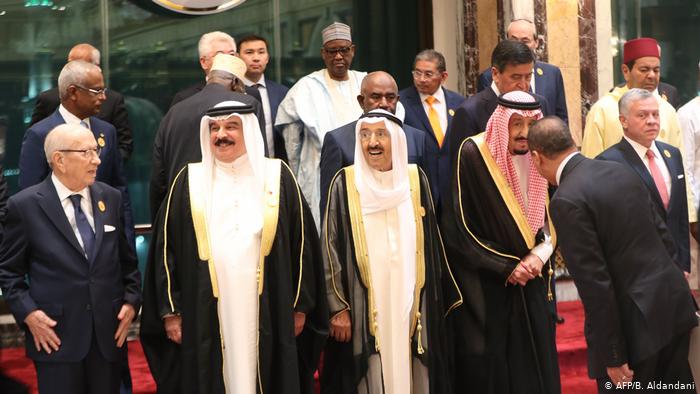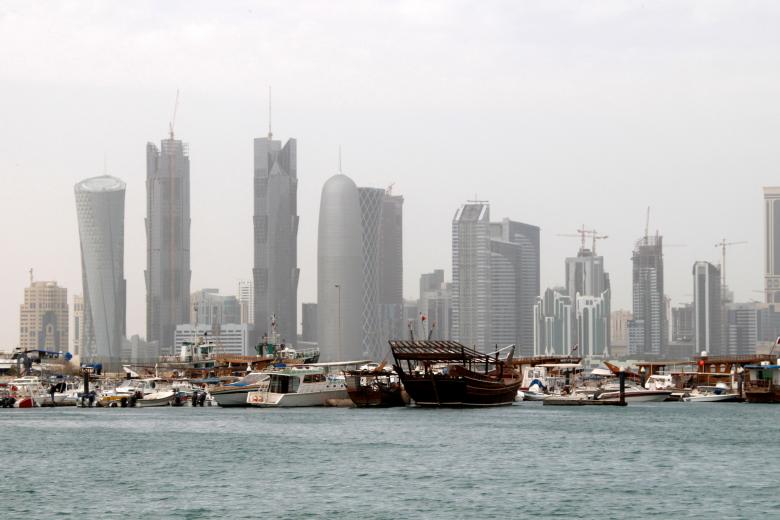
The Arab League’s decision to establish a joint military force should be viewed, above all, as a major accomplishment for Saudi Arabian foreign policy — though Egypt’s president has also been advocating this. It comes with serious risks, however.
It all starts with Riyadh. As Arab Spring uprisings appeared to sweep all before them in 2011, the Saudi regime seemed confident that it was immune. Even after Egyptian President Hosni Mubarak’s swift fall from power. The Saudi leadership’s lack of assurance was betrayed, however, by a series of panicky steps.

Saudi Arabia’s King Salman at Erga Palace in Riyadh, January 27, 2015. REUTERS/Jim Bourg
King Abdullah, who recently died, quickly went on Saudi television to announce extraordinary subsidies, salary raises, an expansion of security forces and more — essentially dispersing tens of billions of dollars in payments to the Saudi people. For added insurance, the Saudis proposed an expanded Gulf Cooperation Council that would include the Arab world’s two other monarchies, Jordan and Morocco. It was more a financial-aid package to create a force of like-minded regimes that could deal with possible insurgencies.
Egypt was then on the other side of the equation: a revolutionary state under the growing influence of the Muslim Brotherhood, which the Saudis never trusted.
With the new pan-Arab force, however, Riyadh has built something far bigger. Not just because of the number of Arab states likely to join, but also because Egypt has pledged to be a central partner.
Egyptian President Abdul Fattah al-Sisi gains a great deal in the process. It could lock in the billions of dollars in Saudi aid he has come to depend on, and elevates the role of Egypt’s military, from which he hails. But Sisi also has something to lose: If he sends troops to a futile war in Yemen, a comparison to Egypt’s former popular leader Gamal Abdel Nasser, which Sisi has sought to cultivate, could come back to haunt him. For Nasser’s 1960s intervention in Yemen was a failure.

Egyptian President Abdel Fattah al-Sisi at a conference in Sharm el-Sheikh, March 15, 2015. REUTERS/Amr Abdallah Dalsh
Historically, though, the most effective Arab actions have come through a Saudi-Egyptian alliance. The 1973 Arab-Israeli War, for example, perhaps the Arab states’ most effective war of the 20th century, was fought largely by Egyptian and Syrian troops. But the Saudis, along with Algerians and other Arabs, played a key role economically and politically because oil was an essential weapon.
In 1991, when Saudi Arabia decided to cooperate with a U.S.-led force to expel Saddam Hussein’s Iraq from Kuwait, Riyadh was emboldened to participate by Cairo, whose support Washington had secured even before asking the Saudis. In fact, after the war, Hussein told his aides that he blamed Mubarak for the Arab action more than King Fahd of Saudi Arabia because the Iraqi dictator believed the Saudis would have been reluctant to act without Egypt.
Now the Saudis confront the need for immediate action in Yemen. Though Saudi Arabia’s decision to play a war-fighting role is bold and new, no one can underestimate the challenges ahead. Particularly if ground forces are ultimately needed, and attacks from Yemen on Saudi territory expand.
Riyadh, of course, wants to register that it has finally arrived militarily. Though Saudi Arabia is the world’s largest importer of arms, few nations view the kingdom’s military as a major factor in the regional military balance. The Saudi military role is untested, so Riyadh doesn’t want to be alone in the fight, either politically or militarily.
Meanwhile, Yemen is only an immediate part of a broader Saudi fear that extends far beyond its strategic competition with Iran.
The Saudi concern about Iran is not so much a direct military one, nor even about Tehran’s nuclear potential. True, the Saudis don’t want to see Iran become a nuclear power. But Riyadh’s biggest worry is Iran’s expanding political influence in Arab lands, especially in its neighborhood.

Saudi Arabian troops cross the causeway leading to Bahrain in this still image taken from video March 14, 2011. REUTERS/Bahrain state TV via Reuters TV
That competition is, at its core, not sectarian. But it exacerbates sectarianism in a way that’s threatening to Saudi Arabia. The Saudis do worry about the rise of Iranian-backed Shi’ite Arabs. But what they have discovered is that sectarianism can also nurture the type of Sunnis who want the regime’s demise even more than some of the Shi’ites do.
In that sense, Riyadh’s fear in the early days of the Arab Spring has been modified. The Arab public’s stalled aspirations after what looked like early successes, coupled with the continuing tragedies in Syria, Libya and Yemen, have put the brakes on those who may have revolted elsewhere in the Arab world. Yet the vacuum created by these stalled uprisings, the failed states and the intensifying sectarianism has given militant Islamists more recruits and a passionate mission that targets the Gulf monarchies as enemies.
Islamic State served as a wake-up call for the Saudis and other Arabs. Not only because of its ruthlessness and swift expansion. But also because Islamic State’s focus is far different from that of al Qaeda, which, though it opposed Arab regimes, targets the United States and largely operates far from the Arab heartland in Afghanistan. Islamic State, by contrast, is intent on changing the regimes in Arab lands. It operates in Saudi Arabia’s backyard and could become a serious problem on the home front, far more than Saudi Shi’ites could ever be.
The pan-Arab force is also designed to be partly political. It spreads the responsibility and the blame. It could provide added legitimacy beyond the resolutions of the Arab League, which most Arabs long ago stopped taking seriously.

A Bedouin honour guard marches before the arrival of Egyptian President Abdel Fattah al-Sisi at the airport in Amman, December 11, 2014. REUTERS/Muhammad Hamed
A key point, though, is that the force provides a formula for broadening the Egyptian-Saudi relationship, now essential for both countries, into an Arab arrangement. Its very creation, at a time when Arabs seemed inept, divided and incapable of taking things into their own hands, is psychologically important. It registers strong resolve just before an anticipated deal between Iran and world powers on the nuclear issue, which Arab rulers fear will expand Tehran’s influence at their expense.
In addition, the joint Arab force has a potentially important, if limited, military role. It is hard to imagine, for example, that it could face down militarily powerful states such as Iran, Israel or a Western power. It’s principally aimed at insurgencies within the Arab world — and not even all of them. Consider: Given Iraq’s largely Shi’ite government, Iran’s influence there and the U.S. role, it is hard to envision a circumstance in which Arabs could intervene.
As for Syria, the Saudis are caught between their hatred for Islamic State and their hatred for President Bashar al-Assad. Riyadh’s vision for Syria does not exactly coincide with that of Egypt, which also doesn’t like Assad but fears his collapse more. The tension over this issue was reflected in the recent Arab summit, when Sisi welcomed a statement by Assad’s backer, Russian President Vladimir Putin, while Saudi officials pointedly criticized it.
In the short term, though, the Saudi vision is for using the Arab force in the growing chaos in Yemen, while the Egyptian vision is for using it in the growing chaos in Libya. For most others outside the Gulf Cooperation Council, the pan-Arab effort is about reaping economic and political rewards. That may be enough to make it work. But the real test is likely to come soon enough in the outcome of the Arab intervention in Yemen, even if that takes place before the joint force is formally established.
The biggest obstacle to an effective joint Arab force, however, may be larger than even the typical differences among Arabs: Dealing with insurgencies and failed states — the problem the force was created to address — requires more political and economic means than military prowess. And much of the simmering anger that fueled the Arab uprisings in the first place had been aimed at many of the governments now leading the way for a pan-Arab force.



